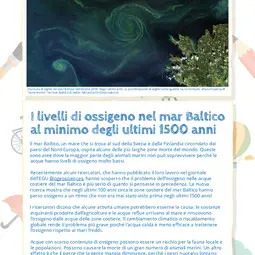Oxygen levels in Baltic Sea at 1500-year low
5 July 2018
The Baltic Sea, a sea to the south of Sweden and Finland surrounded by northern European countries, is home to some of the world’s largest dead zones. These are areas where most marine animals can’t survive because the waters have very low amounts of oxygen. Now, researchers who published their work in the EGU journal Biogeosciences have discovered that the oxygen problem in the coastal waters of the Baltic sea is more serious than previously thought. The new research shows that during the past 100 years or so the coastal Baltic Sea lost oxygen at a rate that had not been seen in 1500 years! The researchers say some human activities could be to blame: pollution due to agriculture and sewage runs off into the sea and results in the water in the coastal areas losing oxygen. Climate change or global warming is making the problem worse because warm waters are not as good at holding on to oxygen as colder seas. Waters low in oxygen can be very bad for the local environment and populations. They can result in marine animals dying in large numbers. Another effect can be that less fish is available for people to eat because the fish swim away from areas with low oxygen. Many countries in the Baltic region have taken steps to reduce pollution, but the study suggests more is needed to save coastal waters.Find out more
Discuss with your parents or teacher
What are dead zones and what causes them? How do pollutants (excess nutrients) contribute to lower oxygen in coastal waters? Find out more at egu.eu/5SJAPR.
What is climate change? Find out more on the NASA Climate Kids website egu.eu/5NSIW8.
Print version

This is a kids' version of the EGU article: 'Oxygen levels in Baltic Sea at 1500-year low'. It was written by Bárbara Ferreira (EGU Media and Communications Manager), reviewed for scientific content by Sara Mynott (University of Exeter) and Sami Jokinen (University of Turku), and for educational content by Sally Soria-Dengg (School Cooperations, GEOMAR Helmholtz Centre for Ocean Research Kiel, Germany).
Translations










All English-language Planet Press releases are carefully edited, reviewed and proofed, by scientists, educators and EGU staff. Please note that once translated, Planet Press releases receive no further checks from EGU staff. For this reason, we cannot guarantee their accuracy, though we trust the quality of our voluntary translators and are grateful for their work.

